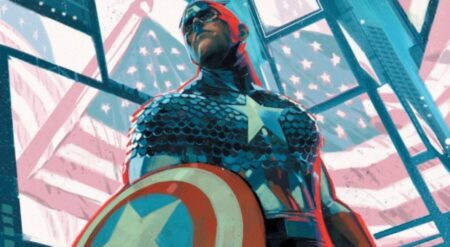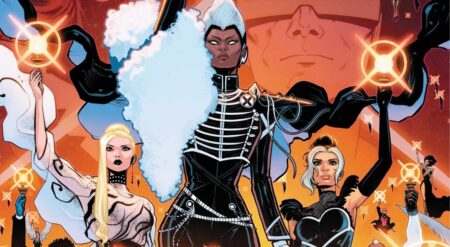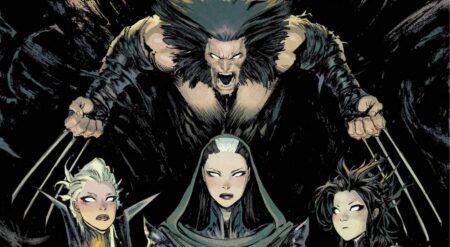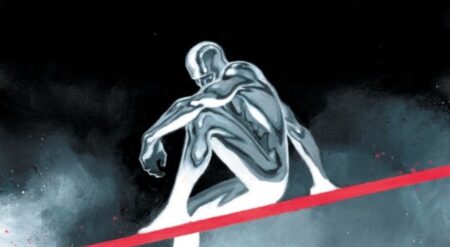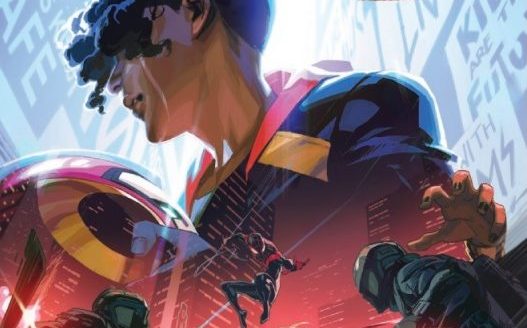
Champions #2 is published by Marvel Comics. The writer is Eve L. Ewing with art by Simone Di Meo and Bob Quinn. Colours are by Federico Blee. Letters provided by Clayton Cowles.
This is the main series for the Outlawed event. Following a huge explosion at a school caused by Viv Vision, all young superheroes have been banned. With Kamala’s law now in place, any young person fighting crime without supervision will be arrested. The Champions are reduced in numbers and have gone underground, meeting in secret. Their hideout was invaded by agents of C.R.A.D.L.E., the task force created to tackle the powered youth. They are extremely dangerous and armed with their own costumed soldiers, such as Justice (Vance Astrovik), a former Avengers. Losing more of their friends, those remaining realize there must be a traitor amongst them…
In this issue, a mass protest takes place in Chicago between the two sides of the debate: those for and those against Kamala’s Law which brings the violent attention of C.R.A.D.L.E. Both sides of the argument at the protest are given their own voice, with safety being the main concern for those in favour of the new law. In contrast, those opposing the law are vehemently dedicated to freedom. Watching the protest from above are the Champions Trinity: Ms. Marvel, Spider-Man, and Nova. Deciding they need help, they try to find the hometown hero, Riri Williams (Ironheart). All this happens while their friends and teammates are held captive in what those running them call “Re-education centres”.
The underlying tension that hummed throughout the first issue of the series continues to thrum in Champions #2, and one of the reasons for that is the pace. The comic is slow-building and dialogue-driven. The conversation the three Champions have with Riri takes up a lot of the second half of the story. And while it is slow, there is the dread that at any point they will be under attack.
Ewing continues to be a perfect fit for writing these characters, but she is an expert at scripting Riri. A lot has changed for these four heroes, and there is a lot they have to get off their chests. Each one of them is very alike in that they are stubborn and have large egos. But Kamala’s shyness, Sam’s headstrong attitude, and Miles’ cautious nature all shine through when they are together.
The actions that C.R.A.D.L.E. takes, and much of the comic’s concept, is based on historical and present relevance, brought up by the characters themselves. Ewing doesn’t shy away from this at any point, tackling the issues powerfully.
The dialogue is where the interactions shine. Ewing excels at showing how much these four know each other and how much they have been through. Riri is very reluctant to don the armour again, and her reasons why are both valid and understandable. She has harsh words for the others, especially Kamala. These heroes have never been so at odds with each other. All of them have vastly different backgrounds which influence how they are dealing with the situation.
The art continues to be jaw-dropping in its beauty, split between two artists in Champions #2. The lines drawn by Di Meo are imperceptibly thin in the first few pages while the characters are outside. The characters in the costumes look fantastic, the proportions of each character very unique. But when the characters go inside, the artist changes and Quinn takes over. Quinn’s lines are thicker as he has a much more traditional drawing style. The facial expressions are fantastic. Riri’s anger at Kamala is evident right from the curled snarl on her lips. Even when it comes down to the shapes of their faces and features, the heroes are all individuals.
The other crucial achievement of both artists is that the superheroes all look young. Either when poised on a rooftop or crowded around a couch, their youth is clear. This is very important in stories where the age of the characters has an impact on their plight. Ms. Marvel, Ironheart, Nova, and Spider-Man are all sinewy, slight, and small, very different from their adult counterparts that have been affected by years of training and crimefighting.
Bree adapts flawlessly to the change in artist, accentuating the styles of both. When teaming up with Di Meo, the scenes have this dream or nightmare-like quality. The haze is created by the lighting, encouraging a surreal atmosphere in some instances. When alongside Quinn, things appear more real and grounded. Bree’s use of lighting is still stunning, with light glinting off of Nova’s helmet but not items such as Spidey’s uniform. The sun shining through one window creates a feeling of warmth inside the house. The vibrancy of the in-costume heroes within the natural light is almost comical. It provides a brief moment of lightness amidst the darkness of their situation.
Cowles keeps the word balloons easy to read and identify, helpful when there is so much dialogue within the comic. The SFX are small, lively, and fit the aesthetic of the book well.
Champions #2 follows a brilliant first issue with another fantastic chapter. Ewing takes four of Marvel’s best, young heroes and uses them to explore dark themes. Their personalities are very likable and will surely be explored as the event picks up momentum. The art is stunning and influential in creating the tense atmosphere the pages radiate. The unease and nervousness that shrouds the comic keep the readers devoted to the pages. As Outlawed continues, it is impossible to know what will happen to these characters next.
Champions #2 is available wherever comics are sold.
Champions #2
TL;DR
Champions #2 follows a brilliant first issue with another fantastic chapter. Ewing takes four of Marvel’s best, young heroes and uses them to explore dark themes. Their personalities are very likable and will surely be explored as the event picks up momentum. The art is stunning and influential in creating the tense atmosphere the pages radiate.

